You may have noticed, it is months since I put up a new post. I actually have three drafts on the go at the moment on different subjects. One of them being part 2 of the Micro-cremator story, I know it’s almost a year since I promised it would happen, but life interrupted. I have been doing heaps of research in the meantime.
My excuse, a mental breakdown as a result of the insanely stressful new admin job in the local Emergency Department. A couple of trips to Sydney to the Mitchell Library, Covid home isolation, as I was there as the Delta pandemic started in June. And starting a new role in Community Health and Medical Records. All have interrupted the writing process.
But now, we are back.
To the Ballantyne discoveries. I am insanely lucky once again to have the most wonderful photos of these members of my family, despite the fact that they passed away 117 and 130 years ago.
This is my 3x Great Grandmother, Margaret Kennedy Ballantyne, née Smith and following her, her husband, my 3x Great Grandfather, David Hunter Ballantyne.

Figure 1: Courtesy of Cousin, Sally Mellick.

Figure 2: Courtesy of Cousin, Sally Mellick.

Figure 3: Courtesy of Cousin, Sally Mellick.
Margaret and David are on the Macvean side of the family tree. I have a ton of information stockpiled on them and will share in future posts. This post is really about the most recent discoveries I have unearthed on them, which have been so exciting.
Both Margaret and David were born in the ancient county of Roxburghshire, in the southern Scottish Borders area. Margaret in the village of Cavers and David in the village of Ashkirk. About 8.5 miles away from each other.

Figure 3: Courtesy of Google Earth

Figure 4: Courtesy of Google Earth
Margaret was three years older than David. I can’t help but wonder what brought these two together. Was eight miles a chasm of distance that their relationship managed to traverse, or was this the usual way of meeting life partners, at the gathering of neighbouring villages? It would be fantastic to find a letter or journal of theirs, but I’m sure they are long gone too.
Check this out below, a couple of taps of the keys, a few dollars to Scotland’s People and I discover my 4x Great Grandfathers’ professions’, confirm the maiden names of both Grandmothers and also find out the areas that both sets of families are from. Now, these are some ancient discoveries, just like the title promises, over 200 years old.

Figure 4a: Courtesy of Scotlands People
https://www.scotlandspeople.gov.uk/
To give some historical context here, below is a copy of an article from the local newspaper the day after Margaret’s birth. At this time, George the III (Queen Victoria’s Uncle) is in the dying days of his reign. The Prince Regent, soon to be George the IV (Another Uncle of Trina’s) has given a proclamation just two weeks before Margaret’s birth with regard to some significant civil unrest that had been brewing.

Since the end of the Napoleonic wars, just 4 years earlier, there had been a number of contributing factors that resulted in this unrest and led to the Prince making this proclamation. According to Wikipedia, they were: a number of acute financial slumps, crop failures, chronic unemployment and the Corn Laws that were keeping bread prices high. Reformists at the time identified Parliamentary reform as the solution and petitioned the House of Commons for reforms to male suffrage. Only 11% of men at the time had the right to vote. The petition was resolutely defeated. Reformists organised to mobilise huge crowds to force the Government to back down. Just eleven days after this article appeared and 12 days after Margaret’s birth, the Government sent in the 15th Hussars with sabres drawn to disperse a huge protesting crowd in Manchester and massacred 17 people and injured up to 700 people in the ensuing confusion. It would become known as the Peterloo Massacre. https://en.wikipedia.org/wiki/Peterloo_Massacre
By the time David is born three years later, the British Regency period has ended and the reign of George IV has started. To give a little more historical context, at the time of David’s birth the British Empire is actively involved in slavery. The Slavery Abolition Act is still 10 years into the future. https://vanessariley.com/blackpeople.php

Figure 4b: Courtesy of Scotlands People
https://www.scotlandspeople.gov.uk/
The day after David’s birth, the 6th of January, The Caledonian Mercury prints copies of the opening speech to Congress by the 5th President of the United States, James Monroe and excerpts from Napoleon’s diaries detailing the loss of the Battle of Waterloo, (just 5 years earlier) what he did in the days after the loss and his eventual abdication. https://www.britishnewspaperarchive.co.uk/viewer/BL/0000045/18230106/009/0002?browse=true

Context in place, now back to the Birth & Baptism records. As you can see in Figure 4a, Margaret’s parent’s, James Smith & Margaret Kennedy, run the local Blacksmiths business in Coldmill. Next to nothing online exists referring to a place in the area called Coldmill, then I came across this one entry.

Figure 4c: Courtesy of Scotland’s Places
https://scotlandsplaces.gov.uk/digital-volumes/ordnance-survey-name-books/roxburghshire-os-name-books-1858-1860/roxburghshire-volume-08/45
The information here lines up with the fact they are from the Cavers Parish, live in a place called Coldmill and there on this document is the mention of the Smithy and garden attached to the property owned by Mr Douglas Esq. of Cavers House. I then found this wonderful mention on an ancient map of the area from the National Library of Scotland.

Figure 4d: Courtesy of the National Library of Scotland
https://maps.nls.uk/geo/explore/#zoom=16&lat=55.43018&lon=-2.74293&layers=5&b=1
I know it is 40 years after Margaret’s birth and baptism registration, but I’m pretty sure this is the place. The next entry in the Ordnance book above that follows Coldmill, which I cut off, refers to Kinninghall which is sitting just above to the right in this map. I went looking for a photo of the site, but nothing came up. I did find this on Google Maps.
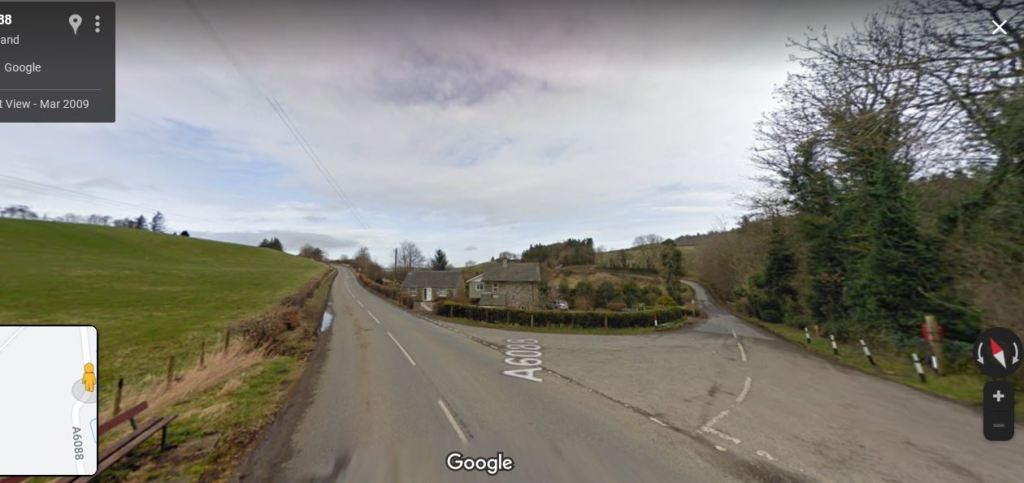
Figure 4e: Courtesy of Google Maps

Figure 4f: Courtesy of Google Maps
Figure 4e is looking straight at the fork in the road, shown on the map. Figure 4f above is up the right-hand side looking back at the fork from the stream. It fits perfectly with the map from 1858. This is where Margaret and her parents lived their lives. How amazing to be able to see it. When the Covid pandemic has settled down, and we are able to travel again, I will definitely be adding my own photos of the place to the family archives.
Now jumping back up to the top of the post to Figure 3, according to Wikipedia, the Cavers Church in this photo was built in 1841 and superseded an old, dilapidated one that stood on the same site. https://en.wikipedia.org/wiki/Cavers,_Scottish_Borders
So this doesn’t fit with our timeline of 1819 for Margaret’s baptism. I only just became aware of my mistake when I stumbled on to these wonderful photos that state they are of the original Cavers church, known as the Cavers Auld Kirk.

Figure 4g: Courtesy of Project Hawick https://www.facebook.com/ProjectHawick/posts/cavers-auld-kirk-as-it-looked-in-1940the-current-building-dates-to-the-17th-cent/1182017308534170/

Figure 4h: Courtesy of Cavers Family History Blog https://cavers0.tripod.com/Cavers.html
It is not the dilapidated one, although I’m sure the family used it before the 1841 version. No, the Auld Kirk sat in the grounds of Cavers House, owned, as mentioned above in the ordnance book, by Mr James Douglas Esq. The ancient Cavers Tower and surrounding lands have been the seat of power for the Douglas family since the 12th century, only finishing when the male line became extinct with the death of this Mr Douglas, the 20th descendent, in 1879. http://www.douglashistory.co.uk/history/Places/cavers.htm

Figure 4i: Courtesy of the National Library of Scotland
https://maps.nls.uk/geo/explore/#zoom=16&lat=55.43220&lon=-2.72855&layers=5&b=1
You will notice on this map that it has a note under the church heading that it was disused in 1823. As we know, Margaret’s baptism was in 1819, which means this is the spot where the family gathered over 200 years ago. You’ll also note that the Manse, noted in the upper left-hand corner, is the block next to the site of the church shown in Figure 3. Also, to show just how close all these family sites were to each other, see the sluice indicated on the left-hand side of this map, it is the same sluice indicated on the right-hand side of the map of Cauldmill in Figure 4d. It really was a small world that they lived in back in the early 1800s.
Some really great news, the Auld Kirk still stands today. I found an online blog with a post from back in 2013 by a bloke named Richard Walker-Hardwick where he details a trip he and a mate, Paul Knox did of the area. They dropped into the site and meet a couple who bought the ancient derelict building back in 2005 and had restored it. They shared some of the histories that they knew, that the building had been used as a village hall for many decades and a Sunday school back in the 1950s and then someone used it to store hay which apparently rotted out the floorboards. https://stcuthbertsfinaljourney.com/2013/04/25/cavers-to-the-derwent-blind-dogs-ruined-houses-modern-day-pilgrims-and-a-crab-trapper/

Figure 4j: Courtesy of Cavers Family History Blog
I sent a thank-you email to Richard for sharing his story, not expecting that I would get a response, but I received one a couple of hours later thanking me for getting in touch. We are planning on meeting up in the UK when we can travel again. Here is a picture of the Auld Kirk restored, a huge thank you to Pauline & Trevor Kelly for their efforts.

Figure 4k: Courtesy of Issuu, Online Marketing Magazine
https://issuu.com/bordermarketingcompany/docs/caversauldkirk
And just to finish off, I found a couple of mentions of Reverend Mr Strachan, who baptised Margaret. His presentation to the Caver’s parish from 1809, which is insanely long ago, and his death notice.
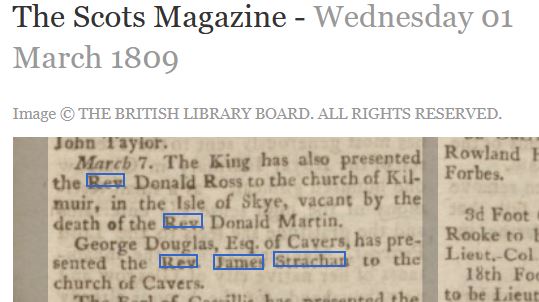
Figure 4l: Courtesy of British Newspaper Archives https://www.britishnewspaperarchive.co.uk/viewer/bl/0000546/18090301/025/0076

Figure 4m: Courtesy of British Newspaper Archives https://www.britishnewspaperarchive.co.uk/viewer/bl/0001174/18400709/027/0002
Now turning to David’s baptism notice. (Figure 4b) David’s father, Robert Ballantyne is a shepherd at a place called Wester Essenside, and his mother, Margaret Hunter presumably, is working by his side. This is where things get a bit hazy. Despite my efforts, there is no record of Robert and Margaret’s marriage on Scotland’s People, no record of their births and no record of their deaths.
I did find a few articles on British Newspaper Archive that mention Robert Ballantyne winning some produce awards at the local horticultural shows, but I can’t be certain that it is him without another point of reference to lock it in. I did find one very interesting article that mentions a George Ballantyne from Wester Essenside.

Figure 4m: Courtesy of British Newspaper Archives
Considering the time and the fact that it is such a small area that we are focusing on, surely George must be related? Is he Robert’s father, my 5 x Great Grandfather? Or an Uncle? It would fit with the timeline.
I did find a birth registration for a Robert Ballantyne from 1802 which again tantalising fits, father is George, and he is a farmer from Wester Essenside. Oh, we are so close, but can’t quite lock it in.

Figure 4n: Courtesy of Scotland’s People
Ancestry.com has George and Elizabeth Ballantyne in a number of trees, but none that link with my Robert and David Ballantyne details. I don’t have any parents listed in my tree for Robert and I had never heard the name Elizabeth Wright before. So for the moment, we will just have to hope we are looking at the rest of the family.
What we can be certain of, as it is stated on David’s Birth & Baptism record, is that my Robert and Margaret Ballantyne were living in Wester Essenside and that it is only 2.3 miles from the Ashkirk church. The map below is from 1840 and shows just how close these family sites were.

Figure 4o: Courtesy of National Library of Scotland
https://maps.nls.uk/counties/rec/675
I love how after nearly two centuries of time the fork in the hand-drawn map above showing where the church and manse are situated are clearly still recognisable in the Google map picture below in Figure 6b.

Figure 5: Courtesy of Canmore.uk.org

Figure 6: Courtesy of Canmore.uk.org
The Ashkirk Parish Church, pictured above in 1920, was rebuilt from an earlier version in 1790. David’s baptism took place on the 22nd June 1823, but we can see from the registration above that the baptism took place in the manse, not the church. I found the one and only picture of the manse online from around the 1930s.
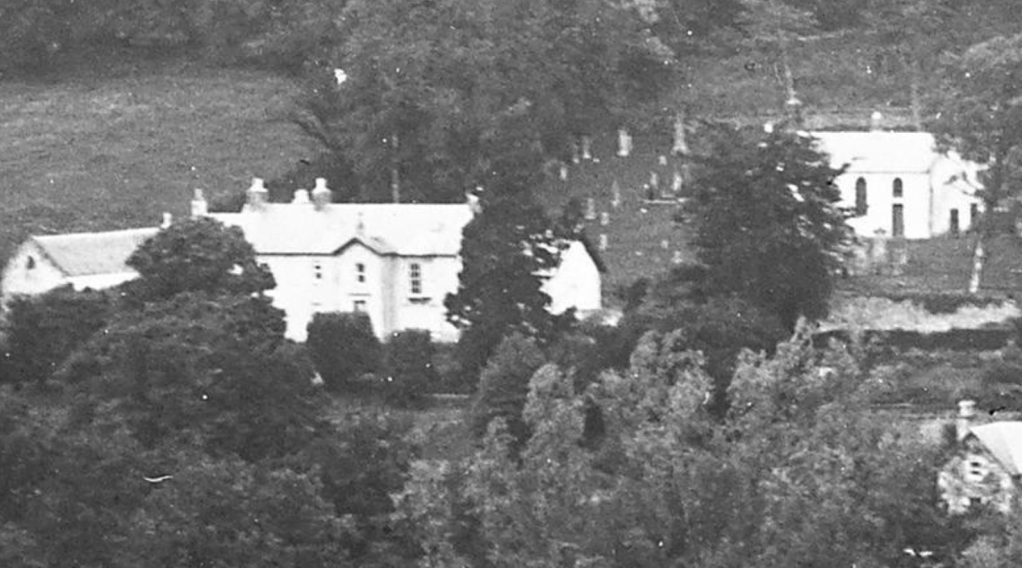
The Manse is the building there on the left and has the peaked awning above what looks like the entrance. It is tantalising to think that this is where David, as a baby and his parents, Robert and Margaret, were on that day. And again luck is on our side, the Manse is still standing along with the church. This was as close as Google would get from the fork in the road and time-wise as well, 2009.

The other thing we can be certain of is that sometime after their meeting, Margaret and David obviously make the journey out to Australia, as here I am. Also, that they get married. At the time of writing this, I do know that they married in 1849 in Edinburgh. More to come on this, as this is another whole story that I wasn’t aware of before starting this post.
We have, I think, already started to accumulate some great examples of “… Ancient discoveries…” as promised in the title. (Spoilers, there are more on their way)
I’m going to mix up the timeline a bit here and jump forward to the information I know about David and Margaret when they are already in Australia. The reason being is that it was following this information backwards that lead me to the next lot of discoveries.
One of the first things I discovered about David was that he was a Minister in the Presbyterian Church. Quite a few years back I stumbled onto an online copy of the history of the Presbyterian Church in New South Wales on a site called the Archive. According to this history, David was the first Presbyterian Minister in the Albury area in NSW from 1851. The first services were held in a building in Townsend Street before the first church, St Davids was built in Smollett Street. https://archive.org/details/centenaryhistory00came/page/n623/mode/2up?q=ballantyne

Figure 7: Courtesy of Archive.org
https://archive.org/details/centenaryhistory00came/page/n623/mode/2up?q=ballantyne
How lucky, am I, another wonderful photo of David to add to the collection. These gifts just keep falling into my lap. The online history also states that he ministered to an enormous-sized parish for 17 years and entirely on horseback. The map that I have put together below, shows roughly the area he travelled.

These are fantastic finds in themselves, considering I have no first-hand sources to turn to on the Ballantyne’s. This side of the family, like so many branches on this tree, has long been lost to us. (There are some tantalising branches on Ancestry.com of children and grandchildren of James McMillan & Margaret Kennedy Yorston brother and sister to my 2x Great Grandmother Jessie Davina, but the owners of those branches have not been active on Ancestry for a number of years. So a dead end at the moment.)
These most recent ancient finds have just astounded me at how they just seemed to appear from the tiniest scrap of information shared that has then led me on to the next discovery. It is such an amazing feeling, and so often I’m stumbling onto them late at night or early in the morning when I’m completely alone and no one is about to share the excitement with me.
Taking the 1851 date from the online church history, I started to trawl through Trove, (my old friend) I came across this article first, talking about the destitute state of Albury, obviously from an ecclesiastical point of view.

So David is the Reverend, in Jun 1851. The goal here was to try and track back what David and Margaret’s journey was? When did they arrive in Australia? When was David ordained? And where did they live? None of these things I knew.
The next piece of information to reveal itself, and this one from a month earlier, in May 1851:


Wow, just wow. So much detail again in this article and at such a personal level. An amazing description of what David was studying to become a Minister, what his assessors thought of him, and his application to his studies. Some golden information on his recent history, “…late teacher and catechist at Buninyong.” And, the date and place of his ordination, the evening of Wednesday the 14th May at 7pm, at the United Presbyterian Church in Collins Street, Melbourne.
Surprisingly, I could find nothing on the 14th that mentioned Ballantyne. I changed the search term to just ordination and Yahtzee!


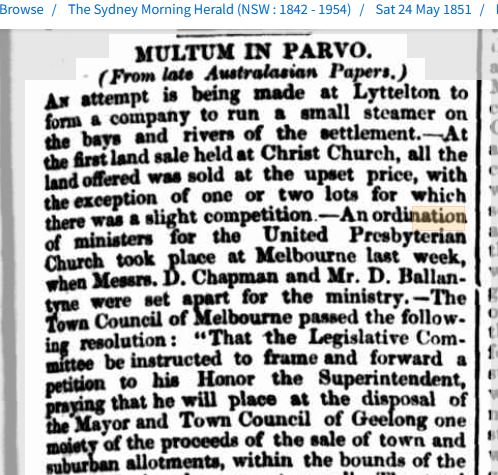
How incredible is that? Notices from the actual day of the ordination in Melbourne and then to find mention of it in the Sydney Morning Herald 10 days later. I wonder if David and Margaret’s eyes ever ran over these very notices?
You will note the names of the Ministers who officiated at the Ordination. The Rev. Messers, Ramsay, Jarrett, Ross, and McNicol, who were all leading players in the story of the United Presbyterian Church at the time.
The Rev. Ramsay & Jarrett helped lay the foundation stone of the Church below where the ordination happened. Trove confirms that the Rev. McNicol & Ross were in attendance.

Collins Street, Melbourne
Figure 14: Courtesy of Auckland Museum.
https://www.aucklandmuseum.com/collection/object/am_library-photography-237100
The original church was built in 1850 and according to another WordPress blog on the history of the company that made the stained glass windows, it was opened on the 30th March 1851, only 7 weeks before David’s ordination. The original church was renovated and extended in 1864, the version above. It survived until 1911 when it was demolished. https://fergusonandurie.wordpress.com/2015/01/04/1864-st-enochs-presbyterian-church-collins-street-melbourne-victoria/

Figure 15: Courtesy of Wikimedia
https://upload.wikimedia.org/wikipedia/commons/7/78/Melbourne_map_1855.jpeg
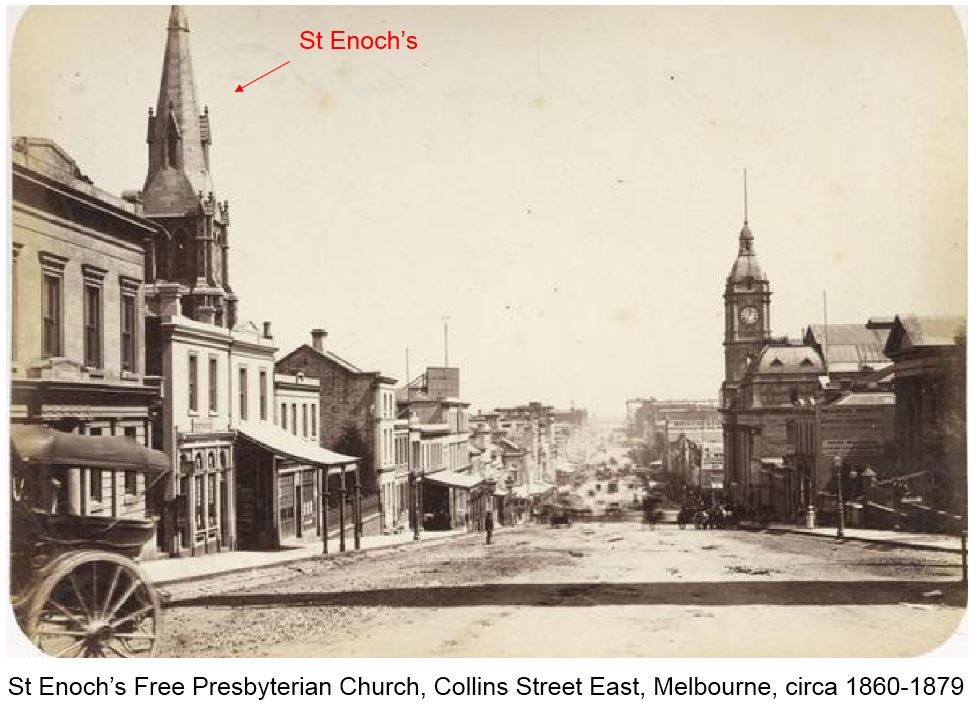
Figure 16: Courtesy of Ray Brown.
https://fergusonandurie.files.wordpress.com/2015/01/melb-st-enochs-01b.jpg
This view above is one that Margaret and David would have been very familiar with. That is the Melbourne Town Hall on the right-hand side of the road with the clock tower. It is still there today in 2021 but hidden behind progress.

Figure 17: Courtesy of Google Maps.
I found notices printed a week later that show David diving straight into his new ministering role and then marrying couples just two months later.


By August 1851, just 3 months from the date of David’s ordination, he and Margaret are on their way to Albury to take up the post of the Presbyterian Minister for that area. At the time, Albury and the lower part of the Riverina were still part of the Victorian Presbyterian Church.

David is 28 years of age, Margaret is 31. They are one month shy of their 2nd wedding anniversary and establishing a life on the other side of the globe from their ancestral homes. My 2x Great Grandmother will not be born for another 3 years. They have one daughter at this stage, Margaret Kennedy Yorston Ballantyne. According to Ancestry.com and some scant details provided by an unknown source, she was born at sea, but no vessel is mentioned.
What I do know, as I mentioned earlier, is that Margaret and David are married on the 19th of June 1849 in Edinburgh, Scotland, which is confirmed by a reliable source, the Scottish Select Marriages Register. This gives us a narrow search window for their arrival, as we now know that in May 1851 they are in Melbourne, and they have had some history in a place called Buninyong teaching. Talk about packing it in, in a short period of time.
So reviewing the information in the article presented in Figures 10 & 11 above, I started searching Trove for mentions of Buninyong for that time period. I struck gold again.

I know I have said this before, but I was grinning like a loon. So lucky again, and it mentions both David and Margaret, what a bonus considering the time. Still referred to as Mrs Ballantyne and not her own name, but at least Margaret is there.
I can’t find a picture of the school, but I did find some information on the history of the school and a couple of photos of Boninyong from around the time.
This is the village from 1862, 12 years after Margaret & David, but it does give a wonderful insight into the very spot they were living.

https://bih.federation.edu.au/index.php/File:M18400-buninyong1862-wiki.jpg
According to the Victoria Heritage website, the school Margaret and David were going to be delivering an “…improved and extended system of instruction…” in, was the first inland boarding school associated with a church in Australia. It was opened in 1848 by the Reverend Thomas Hastie. http://vhd.heritage.vic.gov.au/local/result_detail/156824?print=true

I did a bit of a shallow dive on Trove about the school. It was called the Buninyong Bush Boarding School. I also found a transcript of a talk given to the Port Phillip Pioneers Group back in 2009 by Anne Begg where she explained that it was set up by a couple of bachelor brothers, The Learmonth’s, who recognised that education was essential for all children in the area regardless of their social standing. https://portphillippioneersgroup.org.au/pppg5do.htm
A Trove article published on the 24th May 1848 which was a letter from Thomas Learmonth answering a previously published request on how the school was going to operate explains that they felt removing children from their home situations would give them the best opportunity of learning free of family distractions. Hence the idea of a boarding school.
It is a lengthy letter, but the excerpt below gives a good description of what David and Margaret would be walking into in April 1850. https://trove.nla.gov.au/newspaper/article/91457499?searchTerm=%22Boninyong%20school%22

It is obviously a short tenure as Teacher and Matron of the school as we know that David is taking his vows 13 months later in May 1851 in Melbourne. I found an advertisement in May of that same year looking for another teacher to take up the post but no mention of the Ballantynes departure. I would love to know what the story was that lead to them leaving. Also, how did David fit in all the study that was presumably necessary for his examination mentioned in the article earlier that was undertaken to assess his suitability for the ministry? So, as is the usual case, more questions than answers.
One of the interesting things when searching on Trove is that it has a default setting for displaying your results in a “relevance” list in relation to the search terms entered. This is why so often the articles I find are of a later date than the ones that follow, which is exactly what happened with the Boninyong search.
The next article I came across is from a week earlier than the Boninyong School article above (Figure 21) dated the 11th April 1850. You can probably imagine my delight when I opened this one.

I do hope that other people have these amazing finds in relation to their family history searches like me, as it is amazing.
This article apart from confirming that David is in Boninyong has some awesome bits of information in it. The first, “…the Stratheden…”. Could this be the ship David & Margaret arrive on? It is, just sharing.
The second, look at the name of the Reverend whose church David was an elder in back in Scotland. Reverend A. M. Ramsay! That is the very same Reverend Ramsay who ordains David a year later in Collins St. So that answers some of the new questions posed. David obviously had a shared history with Reverend Ramsay that has been going for some years.
Also, Hawic in the article is actually Hawick and is about 9 miles from Ashkirk and Cavers, David and Margaret’s home villages.
The British Newspaper Archive delivered some very nice information about Rev’ Ramsay and David’s link with the Church.

I love this, an article on the congregation trying to convince Rev. Ramsay not to go to Australia, how specific and what a find. The next is a wonderful mention of David delivering a speech at the local Abstinence Soirée held in the church. This article is pretty special, too, as it confirms that David is a teacher.
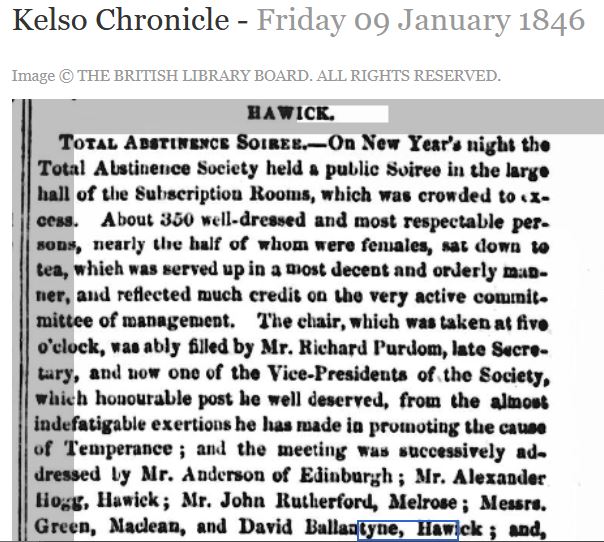

I just found an amazing Facebook page on the history of Hawick, and it has some information on this church David was an elder at and Reverend Ramsay preached at.
It was known as Allars Relief Church, and this incarnation was built in 1816 on Cross Wynd in Hawick. Reverend Ramsay was actually ordained there on the 29th of May 1833. https://adb.anu.edu.au/biography/ramsay-andrew-mitchell-4445

Figure 23: Shows Rev Ramsay who mentored David Ballantyne 
Figure 24: Shows the location of the church David Ballantyne was an elder at. 
Figure 25 
Figure 26
https://www.facebook.com/ProjectHawick/photos/pcb.1441434232592475/1441433635925868

There is the face of the man who mentored and ordained my 3x Great Grandfather. And I can now see exactly what David and presumably Margaret saw on a daily basis, the inside of their local church, all from my office in Forster, NSW, on the other side of the globe. 173 years after them. All of this information gleaned from that tiny typed, phonetically spelt word, Hawic. (Figure 22)
A quick sidebar, I sent the Project Hawick page a message.
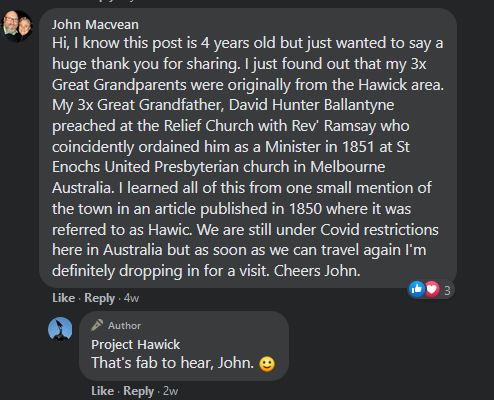
The Australian Dictionary of Biography explains that Rev. Ramsay, as a result of disputes with other ministers at the time, took three other ministers of the Free Presbyterian Church and formed the United Presbyterian order and that he “…obtained ministers from Scotland” https://adb.anu.edu.au/biography/ramsay-andrew-mitchell-4445
Although I have no proof, I think this request for new ministers and their shared history is what leads David and Margaret to immigrate to Australia. Reverend Ramsay paved the way for them and possibly asked them to follow him.
In relation to my previous thought about David and how he fits all the ecclesiastical study in, I found a very specific possible answer to this question. Alexander Romanov-Hughes writes on the Australian Christian Church Histories site that David, “…was an advanced student by the time he arrives in Melbourne…” he doesn’t elaborate on why he describes him like this, but it certainly fits with my thoughts about David’s studies happening well before the 12 months in Boninyong. https://www.churchhistories.net.au/clergy/ballantyne-david-hunter
What a collection of information to uncover on my family from the last 200 years, and it doesn’t stop here.
Turning our attention now to that other fabulous piece of information: The Stratheden. It is indeed a ship, a barque to be precise. A barque according to Collins online dictionary is: a sailing ship of three or more masts having the foremasts rigged square and the aftermast rigged fore-and-aft https://www.collinsdictionary.com/dictionary/english/barque
The picture on the left is of the Helen, a wooden barque of 343 tons and built in 1864. It is a contemporary of the Stratheden and slightly smaller, the Stratheden is listed at 429 tons. Imagine spending 3 -4 months on that with no running water, no toilets and 6- 7 months pregnant, as Margaret was at the time of boarding. https://collections.slsa.sa.gov.au/resource/PRG+1373/40/9
The painting beside on the right is of a 4 masted barque running before a gale, painted by Thomas Jacques Somerscales in 1910. It gives a wonderful example of what it might have been like on the open sea to be travelling in one of these ships. I was unable to find an actual picture of the Stratheden. https://collections.rmg.co.uk/collections/objects/12834.html

Figure 27: Courtesy of the State Library of South Australia https://collections.slsa.sa.gov.au/resource/PRG+1373/40/9
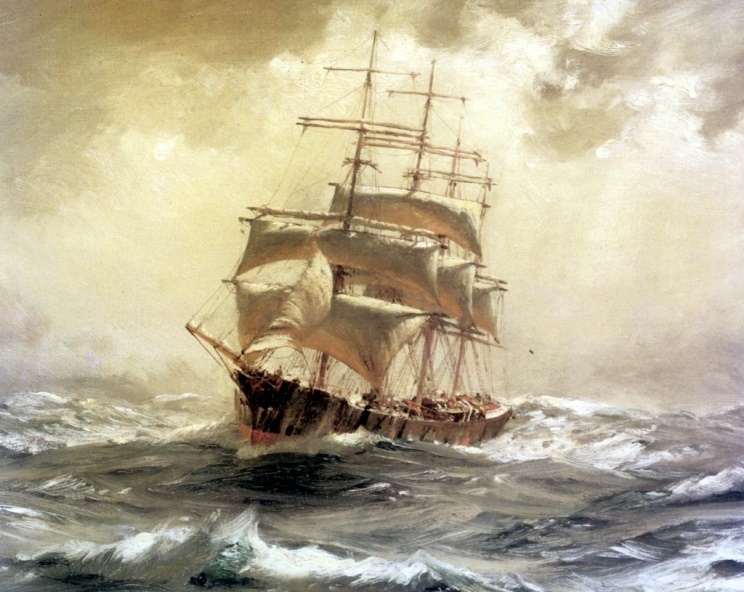
Figure 28: Courtesy of Royal Museums Greenwich
https://collections.rmg.co.uk/collections/objects/12834.html
Armed with the newly revealed name of the ship, this was the next article I found.

Do you see it? David’s name buried there in the middle of the article, spelt incorrectly but still so lucky that it is there. And of course the 19th Century misogyny in all its glory, Margaret referred to again as “…and wife…”
After a couple of weeks of searching, reading, copying, pasting, and typing I have managed to piece together the story of Margaret, David, and eventually baby Margaret’s journey on the Stratheden and their arrival on the shores of the First Nations lands of the Yaluk-ut Weelam clan of the Boon Wurrung, which had recently, (at the time), been proclaimed Sandridge and would eventually be known as Port Melbourne, in the yet to be proclaimed Colony of Victoria. This part of their story continues in the next post.
The is so exceptional. What amazing information and history. All I can say is…… “WOW”. You must be exhausted. Glad to hear you are on the way up again. Take care until we see you and the whole family again…. soon xxo
LikeLike
Aww, thanks Ms Kay. Love your feedback, it is very much appreciated. As I’ve mentioned before It is totally addictive and is one of my real passions now. Look forward to catching up with you and Paul real soon. X
LikeLike
Glad you found something of interest on my WordPress Blog John. The family history thing becomes quite addictive and the story of your forebear Ballantyne is excellent. Thanks for the citations and link too. Regards, Ray.
LikeLike
Thanks for taking the time to comment Ray and your blog was excellent. Thanks for sharing. I know Im slack in not doing a full Bibliography at the end of the article but Im only doing this an amateur for family and anyone else interested. But I will always make sure I cite and link back to any material that is not my own.
LikeLike
How lucky to find so much information confirming their movements, dates and relationships! Wonderful work and worth the wait. X
LikeLiked by 2 people
Thanks My Sweet, love hearing your feedback. X
LikeLiked by 1 person
Absolutely Awesome thank you for sharing Love Mum x
On Sun, Sep 12, 2021 at 4:14 PM John’s Family History Blog wrote:
> John Macvean posted: ” You may have noticed, it is months since I put up a > new post. I actually have three drafts on the go at the moment on different > subjects. One of them being part 2 of the Micro-cremator story, I know it’s > almost a year since I promised it would happen, bu” >
LikeLiked by 1 person
No worries Mum, glad you liked the post. X
LikeLiked by 1 person
Thank you John for this information, there is a lot to digest. I hope all is well with you in this impossible time. We are in lockdown yet again and we are not happy that Sydneysiders can fly into Ballina.
Cheers Phil
On Sun, Sep 12, 2021 at 4:14 PM John’s Family History Blog wrote:
> John Macvean posted: ” You may have noticed, it is months since I put up a > new post. I actually have three drafts on the go at the moment on different > subjects. One of them being part 2 of the Micro-cremator story, I know it’s > almost a year since I promised it would happen, bu” >
LikeLike
Hi Phil, you are most welcome and thank you for taking the time to comment. Hope you enjoy reading it as much as I have searching the story out. Yes, lockdown is not fun, hang in there and stay safe.
Still looking forward to the day we can meet up, Covid Safe of course. Cheers John
LikeLike
Hi John, Just found this information https://alburyhistory.org.au/wp-content/uploads/2021/10/ADHS-Extended-Albury-Timeline-.pdf on ( https://alburyhistory.org.au/about/local-history/).
It has references to Rev. David Ballantyne & gives you an idea of the timeline of events in the settlement of Albury- Wadonga region.
Cheers Phil
LikeLiked by 1 person
Thanks so much Phil, I will check it. Cheers John
LikeLike
Hi John,
I cam across this blog and thought I would share that the Rev AM Ramsay is my Great Great Grandfather. It’s a small world. I would be fairly confident that they were friends. I am pretty sure that David is mentioned in a number of letters I possess of Andrew’s. Just this last year, I travelled to Scotland and went to Hawick. The church is no longer there, but there is a small “edge” of it that matches the same arches in the fantastic picture you posted. The church itself is now a car park. It burnt down. Andrew’s wife came from Cavers which we also visited whilst in Hawick.
LikeLike
Hi Rod,
Wow, fantastic message to recieve from you. Thanks so much for reaching out and sharing your information with me. It is indeed a small world especially with the tech we now have. Imagine trying to explain this instantaneous communication with either Andrew or David.
Rod, if you were willing to share and had some time, I would love to see those letters of Andrew’s that mentioned David. What a gift they are, that you have some of your GG Grandfather’s correspondence. That is amazing.
Everything I have learned about David and the family is all online from Trove, National Archives and British Newspapers. I have no living links to this side of the family and I would assume all their correspondence would be long gone by now.
My email is johnamacvean@gmail.com if you do want to share. No problems if you dont, I know how valuable items like this are.
That is fantastic that you got to visit Scotland. My wife and my two sons and I were all set to go March 2020 then Covid hit and put paid to that. We are hoping to get there next year.
Thanks so much for making contact Rod. I never thought when I started this blog that anybody else outside the family would be interested , so it is such a treat when people take the time to message, such as you did.
Kind regards
John
LikeLike